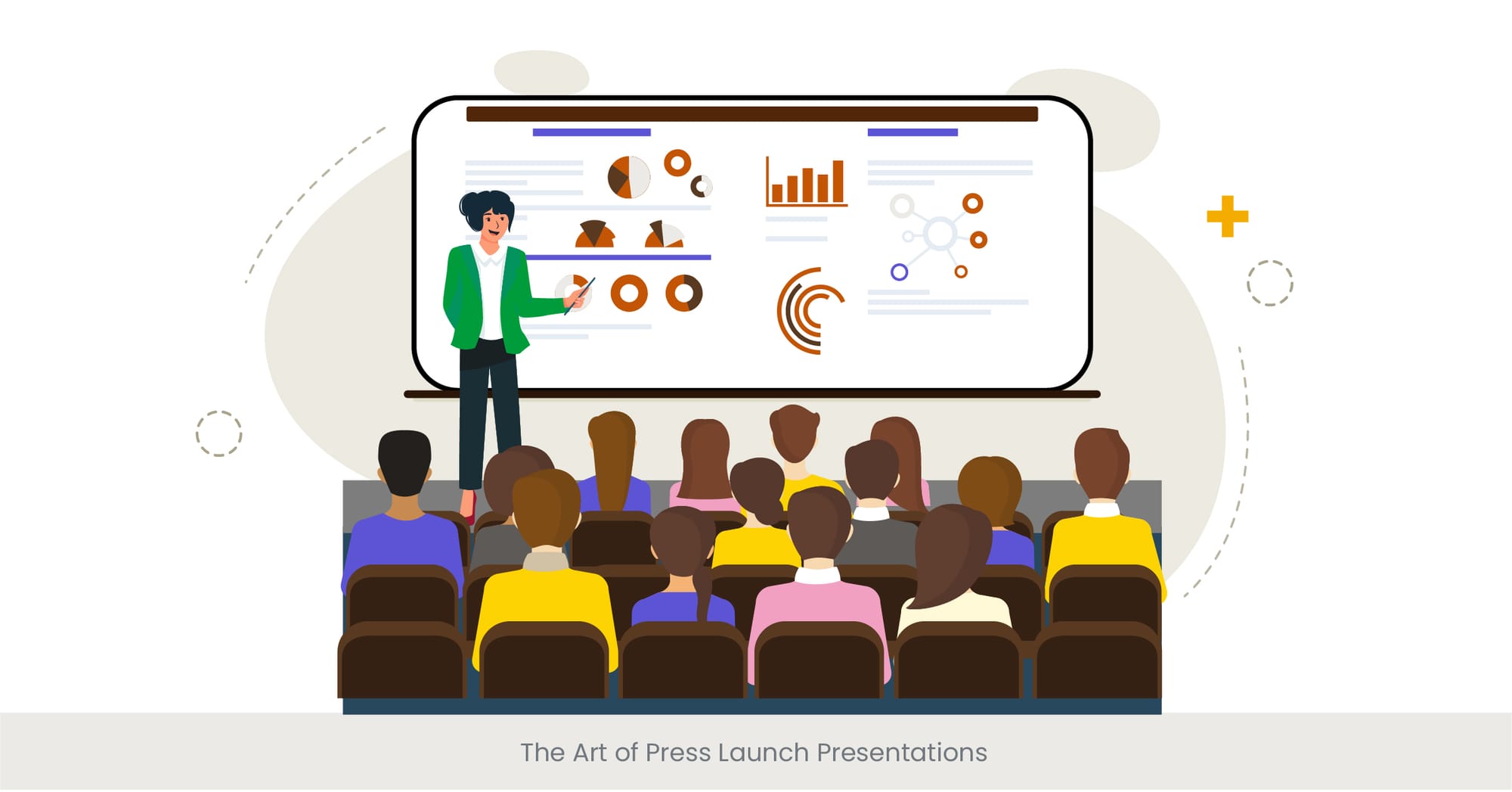
Engaging Every Audience Through Diverse Presentation Styles

The realm of professional presentations is rich and varied, encompassing a broad spectrum of formats designed to communicate, persuade, and inform. From the formal Annual General Meetings (AGMs) to the dynamic press launch events, the art of presentation has evolved to meet the demands of diverse audiences and objectives. This section delves into the essence of presentation formats, highlighting their significance in fostering effective communication in various corporate settings.
The Evolution of Presentation Formats: A Historical Perspective
Historically, presentations were predominantly one-dimensional, with a speaker delivering information to a passive audience. However, as technology advanced and audience expectations shifted, the landscape transformed dramatically. Today, presentations range from interactive shareholder calls to engaging investor relations decks, each tailored to achieve specific goals. The incorporation of digital media, storytelling techniques, and audience participation has elevated the presentation experience, making it more impactful and memorable.
Real-World Applications and Innovations
In the corporate world, AGM presentations serve as a cornerstone, offering a comprehensive view of a company's yearly performance to its stakeholders. Similarly, upcoming events, emerging growth conferences and global business conference decks have become pivotal for companies looking to showcase innovation and drive forward-thinking discussions. A recent trend is the rise of virtual decks, which, through platforms like Zoom and Microsoft Teams, have expanded the reach and accessibility of such events, breaking geographical barriers and fostering a more inclusive environment.
Evidencing Success Through Data and Expert Opinions
The effectiveness of various presentation formats is not just anecdotal; it's backed by research and data. Studies have shown that audiences are more engaged and retain information better when presentations are interactive, interesting and visually appealing. According to a report by Forbes, they found that incorporating visuals into ppts can increase audience engagement by up to 94%. Furthermore, a survey conducted by Harvard Business Review highlighted that presentations tailored to audience expectations significantly enhance message reception and stakeholder satisfaction.
Designing Annual General Meeting (AGM) Presentation

Crafting the Cornerstone of Corporate Communication
Annual General Meetings (AGMs) stand as pivotal events in the corporate calendar, serving as a direct channel for communication between a company's management and its shareholders. Designing presentations for AGMs requires a strategic approach that balances informative content with engaging delivery. This section explores the foundational elements of AGM decks, emphasizing their role in transparent governance and shareholder engagement.
A Deep Dive into AGM Presentation Structure
The architecture of an AGM presentation is critical in conveying the company's yearly achievements, strategic direction, and financial health. Typically, these presentations encompass a review of the past year's performance, a discussion on future prospects, and an outline of governance issues. The inclusion of detailed financials, accompanied by charts and graphs, aids in demystifying complex data, making it accessible to shareholders. Historical context is invaluable, providing a lens through which to view progress and setbacks, thereby setting the stage for future initiatives.
Innovations and Real-World Examples in AGM Presentations
The digital transformation has significantly influenced AGM presentations. Companies are increasingly leveraging technology to enhance interactivity, such as live polls and Q&A sessions, thereby fostering a two-way dialogue with shareholders. For instance, a leading tech giant recently conducted its first AGM presentation virtually, incorporating real-time voting on resolutions, which not only increased participation rates but also elevated the level of engagement among attendees. Such innovations underscore the evolving nature of AGM presentations in adapting to the digital age.
Validating Through Data: The Impact of Well-Designed AGM Presentations
The effectiveness of AGM decks is underscored by their ability to influence shareholder confidence and decision-making. A study by the Investor Relations Society found that 85% of investors believe the quality of an AGM presentation directly impacts their perception of a company's management. Additionally, research indicates that companies that invest time and energy in crafting detailed, accurate and transparent AGM decks tend to enjoy higher levels of trust and loyalty from their shareholders, reinforcing the importance of meticulous and accurate show design and preparation.
Effective Strategies for Shareholder Call Presentations

Maximizing Engagement in Shareholder Communications
Shareholder call presentations are a vital tool for maintaining open lines of communication with a company's investors, especially outside of the annual meeting cycle. These calls, often centered around quarterly earnings, provide a platform for updating shareholders on recent performance, future outlooks, and strategic plans. This section outlines the key strategies for making these decks not only informative but also engaging, ensuring that shareholders feel valued and informed.
Building a Strong Foundation: The Anatomy of a Shareholder Call
Effective shareholder calls are meticulously planned, with a clear structure that respects the shareholders' time and intelligence. They typically start with a brief overview of the financial performance, followed by insights into the business operations, strategic initiatives, and future forecasts. Incorporating clear, concise, and consistent messaging throughout the presentation is crucial. Background information on market conditions, competitive landscape, and regulatory changes can provide shareholders with a comprehensive understanding of the company's positioning and prospects.
Illustrating Success Through Case Studies and Trends
Real-world examples play a pivotal role in bringing shareholder presentations to life. Highlighting case studies of successful strategies or turnaround stories within the company can significantly boost investor confidence. For instance, a multinational corporation might share a case study on how a particular investment led to market expansion and revenue growth, underlining the effectiveness of their strategic decisions. Additionally, showcasing how the company is adapting to industry trends, such as sustainability or digital transformation, can further engage and reassure investors.
The Power of Data and Expert Validation in Shareholder Calls
The credibility of a shareholder call presentation is greatly enhanced by the use of authoritative data and expert opinions. Incorporating statistical evidence and forecasts from reputable sources helps validate the company's performance and strategy. For example, referencing industry benchmarks or analyst ratings can provide a context for the company's results, making the presentation more compelling. Furthermore, testimonials or quotes from industry experts about the company's market position or innovation efforts can add a layer of credibility and interest.
Crafting Investor Relations Presentations

Building a Bridge Between Companies and Investors
IR presentations are a cornerstone in the edifice of corporate communication, serving as a crucial link between a company and its current and potential investors. Unlike an AGM presentation or shareholder call decks, which may have a more specific focus, IR decks offer a broader view of the company's value proposition, strategies, and investment potential. This section discusses the art and science of creating IR presentations that effectively communicate the company's narrative, driving investor interest and confidence.
A Strategic Framework for Investor Relations Decks
The foundation of a compelling IR presentation lies in its ability to succinctly convey the company's story: where it has been, where it is now, and where it is headed. This involves a strategic blend of financial performance, strategic direction, market opportunities, and competitive advantages. Key elements include an executive summary, financial highlights, strategic initiatives, and future growth opportunities. Providing a clear, cohesive narrative that connects the financials and data with strategic decisions and market positions is crucial for engaging savvy investors.
Engagement Through Real-World Examples and Market Insights
To elevate an IR presentation, incorporating case studies or examples of strategic initiatives in action can significantly impact investor perception. Demonstrating how specific investments or decisions have driven growth or improved performance offers tangible evidence of management's strategic acumen. Furthermore, providing insights into market trends and how the company is positioned to capitalize on these trends can highlight potential for future growth, making the investment case more compelling.
Leveraging Data and Third-Party Endorsements to Strengthen the Narrative
The inclusion of data and analytics to support financial results, market analysis, and strategic positioning is critical for an effective IR presentation. Utilizing graphs, charts, and other visual aids can help distill complex information into digestible, impactful insights. Additionally, third-party endorsements from analysts, industry experts, or media can provide an external validation of the company's strategy and market position, further bolstering the presentation's credibility.
Preparing for Emerging Growth Conferences

Showcasing Innovation and Opportunity
Emerging growth conferences offer a unique platform for companies, especially startups and high-growth entities, to present their business models, growth strategies, and future prospects to a curated audience of investors, analysts, and industry peers. These events are critical for gaining visibility, attracting investment, and networking with potential partners. This section explores the key considerations and strategies for preparing compelling presentations tailored for emerging growth conferences.
The Blueprint of an Impactful Emerging Growth Conference Presentation
The essence of a successful presentation at an emerging growth conference lies in its ability to clearly articulate the company’s growth story, innovation, and competitive edge. Presenters should focus on showcasing the company's unique value proposition, market opportunity, technological advancements, and roadmap for future growth. It’s essential to highlight key financial metrics and milestones that signal the company's progress and potential for scalability. Visual aids and storytelling techniques can be particularly effective in illustrating the company's journey and vision.
Real-World Examples Elevating the Growth Narrative
Incorporating case studies or success stories that demonstrate the company's ability to execute its vision and overcome challenges can significantly enhance the presentation's impact. For instance, detailing a breakthrough product development process or a successful market entry strategy can provide concrete evidence of the company's innovative capabilities and growth potential. These real-world examples not only validate the company's strategy but also make the presentation more relatable and engaging for the audience.
Data-Driven Insights and Industry Endorsements to Validate the Growth Story
Supporting the growth narrative with robust data and analysis is crucial for building credibility with a sophisticated audience. This includes market research, competitive analysis, and even financials and projections that underscore the company’s growth trajectory and market potential. Additionally, leveraging industry endorsements, awards, or testimonials can serve as powerful testimonials to the company's reputation and prospects. References to reputable sources and industry reports can further solidify the company's position and potential in the market.
Mastering Global Business Conference Presentations

Navigating the Global Stage with Confidence
Global business conferences present an unparalleled opportunity for companies to showcase their vision, innovation, and capabilities on an international platform. These events attract a diverse audience from various sectors and regions, making them a critical venue for networking, collaboration, and global visibility. This section offers insights into crafting presentations that resonate across cultural and geographical boundaries, ensuring your message not only reaches but also impacts a global audience.
Crafting a Universally Engaging Presentation
The key to a successful global business conference presentation lies in its universality – the ability to engage and appeal to an international audience. This involves careful consideration of cultural nuances, language simplicity, and universal themes of innovation, sustainability, and global market trends. Highlighting the company’s international projects, global partnerships, and cross-cultural teams can demonstrate its global footprint and commitment to diversity. Visual storytelling, enriched with global case studies and examples, plays a pivotal role in making the presentation accessible and relatable to people from different parts of the world.
In the context of global business conferences, event planning presentation slides play a pivotal role in guiding attendees through the agenda. These slides should provide a clear structure of the event, including session timings, speakers, and key highlights. Effective event planning slides enhance the organization and flow, ensuring clarity throughout the event.
Get Your Custom Presentation Today
Illustrating Global Impact Through Examples
Emphasizing the company's global impact through specific examples, such factors such as international success stories, collaborations, and innovations, can significantly enhance the presentation's appeal. Sharing insights into how the company addresses global challenges, contributes to sustainable development, or innovates for a worldwide market not only showcases its global presence but also its role as a forward-thinking leader. These narratives help cement the company's image as a global player committed to addressing universal challenges.
Event showcase presentations offer an opportunity to highlight the success stories of past events, demonstrating how your company has effectively managed or contributed to large-scale projects. These presentations can include case studies or testimonials, emphasizing the company’s ability to handle diverse and impactful events on a global scale.
Discover Our Success Stories
Data and Endorsements: Building Credibility on the Global Stage
Incorporating global market data, trends, and forecasts can provide a solid foundation for the company’s strategic directions and decisions. Utilizing reputable international sources and reports strengthens the presentation's credibility and showcases the company's awareness and understanding of the global market dynamics. Endorsements from international partners, clients, or industry bodies can further bolster the company's reputation and reliability. Such validations are invaluable in establishing trust and interest among a global audience.
The Art of Press Launch Presentations

Captivating Media and Audiences with Your Story
Press launch presentations are a critical moment for companies to unveil new products, services, or initiatives to the media and the public. The goal is to generate excitement, interest, and coverage, turning the launch into a memorable event that captivates and engages. This section discusses strategies for crafting press launch presentations that not only inform but also inspire and resonate with the audience, ensuring the message is amplified through media channels.
Crafting a Compelling Narrative for Press Launches
The essence of a successful press launch presentation lies in storytelling. It's about weaving a compelling narrative that highlights the innovation, benefits, and potential impact of what's being launched. The presentation should start with a clear, engaging introduction that outlines the problem or need in the market, followed by how the company's offering addresses this in a unique and valuable way. Using vivid imagery, demonstrations, and testimonials can bring the story to life, making it more relatable and compelling for the press and attendees.
The rise of interactive event presentations introduces a more engaging experience for board meetings and annual events. By integrating live polls, Q&A sessions, or audience feedback into the presentation, companies can encourage real-time engagement, making the presentation more dynamic. These interactive elements help keep the audience actively involved.
Browse Our Expert Guides
Showcasing Innovation and Impact through Real-World Examples
Incorporating real-world applications or potential use cases of the product or initiative can significantly enhance the article or presentation's effectiveness. Demonstrating how the offering has been tested, the feedback received, and its impact on a small scale can provide tangible proof of its value and potential. Highlighting endorsements from early adopters or partners can also add credibility and intrigue, making the story more persuasive and newsworthy.
Leveraging Data and Expert Opinions to Strengthen Your Case
Data plays a crucial role in press launch presentations, providing a solid foundation for the claims and assertions made. Sharing market research, user statistics, or performance benchmarks can help quantify the offering's potential impact and market relevance. Additionally, incorporating quotes or endorsements from industry experts, analysts, or influencers can lend authority and depth to sections of the presentation, making it more compelling for the media and the audience.
Engaging Presentations for Board Meetings

Strategizing for Impactful Boardroom Communications
Board meetings are a critical arena for strategic decision-making, requiring presentations that are not only informative but also compelling and persuasive. These presentations offer a unique opportunity to influence the company's direction, secure buy-in for new initiatives, and demonstrate leadership and vision. This section outlines key strategies for creating board meeting presentations that engage and resonate with board members, in addition to ensuring your message is clearly conveyed and acted upon.
Foundations of a Persuasive Board Meeting Presentation
The success of a board meeting presentation hinges on its ability to concisely present data, insights, and proposals in a manner that drives decision-making. Starting with a clear outline of objectives, challenges, and avenues sets the stage for a focused discussion. It’s crucial to align the content with the strategic interests of the board, highlighting relevant financial metrics, market trends, and competitive analysis. Using a narrative that ties together historical performance with future projections can create a compelling case for the proposed strategies.
Schedule Your Free Consultation
Illustrating Strategy with Real-World Impact
Utilizing case studies or scenarios that demonstrate the practical application and potential outcomes of proposed strategies can significantly enhance the presentation's persuasive power. For instance, detailing a pilot project's success or benchmarking against industry best practices provides concrete evidence supporting your recommendations. These examples not only illustrate the feasibility of proposals but also help in mitigating perceived risks, making the decision-making process more straightforward for board members.
Data and Validation: The Cornerstones of Credibility
Incorporating comprehensive data analytics, financial projections, and risk assessments is essential for building credibility and confidence among board members. Presenting this data in a clear, visual format can help in quickly conveying complex information. Further credibility can be added through third-party validations, such as market analyses, expert opinions, or customer testimonials, which reinforce the soundness of the proposed strategies and the potential for successful outcomes.
Innovations in Annual Meet Presentations

Reimagining Tradition with Creativity and Technology
Annual meet decks are a staple in the corporate calendar, offering a platform public companies to reflect on the year's achievements, challenges, and the road ahead. However, with the evolving expectations of shareholders, employees, and stakeholders, there's a growing need public companies to innovate these presentations to maintain engagement and interest in upcoming events. This section delves into the latest trends and innovations in annual meet ppts, highlighting how companies can leverage technology and creative storytelling to enhance the impact and reception of their messages.
Integrating Cutting-Edge Technology for Enhanced Engagement
The integration of technology such as augmented reality (AR), virtual reality (VR), and interactive data visualization tools has revolutionized the way annual meet decks are delivered. These technologies offer immersive experiences, making it possible to visualize complex data, simulate future projects, and engage the audience in interactive sessions. For example, companies are now using AR to give shareholders a virtual tour of new facilities or projects, significantly enhancing the storytelling aspect of their presentations.
Stay Ahead with Presentation Trends
Leveraging Storytelling and Multimedia for a Compelling Narrative
Beyond technology, the art of storytelling has become a critical component of innovative annual meet decks. Using a narrative that weaves together the company's milestones, challenges, and visions for the future can captivate and resonate with the audience on a deeper level. Incorporating multimedia elements such as videos, animations, and dynamic infographics can bring stories to life, making the presentation more memorable and impactful.
Showcasing Real-World Successes and Future Visions
Highlighting the company's successes through case studies, customer stories, and testimonials can provide tangible evidence of its impact and value. Furthermore, presenting future visions and strategies through scenario planning, forecasts, and interactive discussions can engage the audience in the company's future direction, encouraging feedback and participation. This approach not only validates the company's past and present performance but also aligns stakeholders with its future aspirations.
Data and Insights: Driving the Innovation Narrative
Supporting the narrative with data and insights is essential for credibility and impact. Innovative decks often incorporate live data feeds, benchmarking studies, and predictive analytics to provide a real-time, comprehensive view of the company's performance and market trends. These data-driven elements, combined with expert insights and industry forecasts, help in painting a compelling picture of the company's position and potential, reinforcing the strategic messages conveyed.
Tailoring Content for Diverse Audience Expectations

Navigating the Spectrum of Stakeholder Interests
In today's multifaceted corporate environment, presentations must cater to a wide range of stakeholders, each with their unique perspectives, interests, and expectations. From investors and board members to employees and the general public, crafting content that resonates across this diverse audience spectrum is a formidable challenge. This section explores strategies for tailoring presentation content to meet varied audience expectations, ensuring your message is impactful and inclusive.
Understanding Your Audience: The First Step to Effective Communication
The foundation of any tailored presentation is a deep understanding of the audience's characteristics, needs, and expectations. Conducting audience analysis before designing your presentation can provide valuable insights into their interests, knowledge level, and what they seek from the presentation. This understanding allows for the customization of content, tone, and delivery style to ensure relevance and engagement. For instance, investors may prioritize financial performance and growth prospects, while employees may be more interested in company culture and future plans.
Striking a Balance: Universal Themes and Specific Interests
One effective approach is to structure the presentation around universal themes that have broad appeal, such as innovation, sustainability, and growth, before diving into details more relevant to specific audience segments. Utilizing storytelling techniques that feature relatable characters or scenarios can help bridge the gap between diverse interests, making the content accessible to all. Additionally, segmenting the presentation to address particular topics of interest to different audience groups can ensure that each segment feels acknowledged and valued.
Interactive Elements and Customized Content
Incorporating interactive elements such as Q&A sessions, live polls, and breakout discussions can cater to varied audience interests by allowing participants to steer the conversation towards topics of particular relevance to them. Furthermore, leveraging adaptive content, with items such as dynamic slides or digital handouts that participants can select and explore at their own pace, enables a personalized experience, ensuring that each audience member derives value from the presentation.
Leveraging Data and Insights to Unify and Persuade
Data and insights play a crucial role in tailoring content for diverse audiences. Presenting data in various formats (charts, graphs, infographics) can cater to different preferences for information processing. Additionally, incorporating case studies, benchmarks, and forecasts can provide a common ground for all audience members, facilitating a unified understanding and appreciation of the presentation's key messages.
FAQs
What is a shareholder presentation?
A shareholder presentation is a communication tool used by a company's management to report financial performance, strategic initiatives, and future prospects to its shareholders. It often includes updates on market position, competitive advantages, and financial health, aiming to maintain transparency and foster shareholder trust.
What does an investor presentation include?
An investor presentation includes slides with an overview of the company's financial performance, strategic direction, market analysis, competitive landscape, and future growth opportunities. It's designed to provide current and potential investors with a comprehensive understanding of the company's value proposition and investment potential.
Can anyone listen to an earnings call?
Yes, earnings calls are typically open to the public, including investors, securities analysts, and journalists. Companies often provide access through the form of a webcast on their website or a teleconference line, allowing interested parties to listen to the quarterly financial results and management's discussion of the company's performance.
What is the difference between earnings release and earnings call?
An earnings release is a form of a written document that provides a summary of a company's financial performance for a specific period, while an earnings call is a form of a conference call or webcast where the company's management discusses the full year of financial results, answers questions, and provides additional context about the company's performance and outlook.
What is an annual presentation?
An annual presentation typically refers to the presentation given at a company's Annual General Meeting (AGM), summarizing the financial and operational highlights of the past year, outlining future strategies, and addressing shareholder queries. It's a key tool for corporate governance and a form of shareholder engagement for public companies.
How to do a presentation in a meeting?
Doing a presentation in a meeting involves preparing a clear, concise, and engaging presentation that meets the objectives and interests of the audience. Start with a strong introduction, structure your content logically, use visuals to enhance understanding, practice your delivery, and anticipate questions for the Q&A session.
How do you start a conference presentation example?
Starting a conference or talk or presentation effectively can involve sharing a surprising statistic, telling people a relevant story, asking a thought-provoking question, or stating a bold claim to grab the audience's attention. The opening should be relevant to the present topic and set the tone for the rest of the talk or presentation.
What is the meaning of presentation in a meeting?
The meaning of a presentation in a meeting is to convey information, persuade, or facilitate discussion on a specific topic or agenda item. It serves as a structured way to share insights, updates, or proposals, often supported by visual aids, to achieve the meeting's objectives.
How to do a presentation for new product launch?
A presentation for a new product launch should highlight the product's features, benefits, and competitive advantage. Start with the customer need or problem the product addresses, showcase the product, provide evidence of its value, and conclude with the launch details and a call to action.
How do you open an exciting presentation?
Opening an exciting presentation can be achieved by using a compelling story, interesting fact, or engaging question that directly relates to the present topic. The goal is to capture the audience's interest, energy, and curiosity from the very beginning.
What is a good product presentation?
A good product presentation effectively communicates the product's value proposition, in addition to demonstrating how it solves a problem or meets a need. It should be clear, concise, engaging, and include demonstrations or examples to illustrate the product's benefits.
How do you write a product launch?
Writing a product launch involves outlining the key messages about the product, with factors as its features, benefits, target market, and how it stands out from the competition. It should also detail the products' launch strategy, with factors including marketing efforts, distribution channels, and post-launch support.



%20(1).jpg)
%20(1).jpg)


